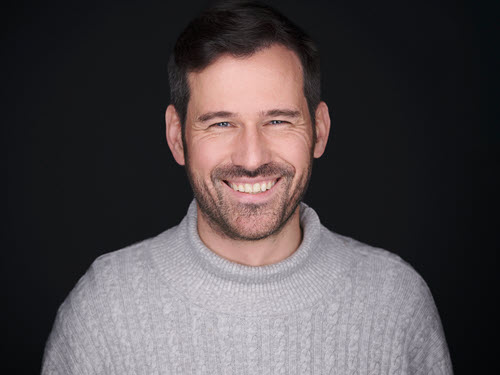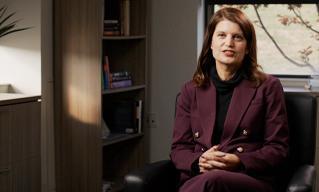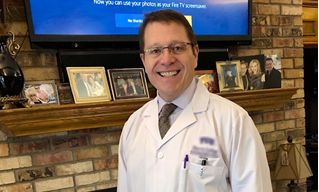In medicine, physicians are sometimes detectives. They look for clues, follow hunches and gather evidence that will allow them to diagnose and treat their patients. As a young cardiologist, James Richardson, M.D., enjoyed this sleuthing aspect of patient care. "It’s a straight-line process: deduction, intervention and outcome," he said.

While common conditions like diabetes and heart disease often follow this clear path—diagnosis, treatment, outcome—the journey is rarely so direct for those living with rare diseases. Diagnoses can take years, and even when they come, treatment options are often limited. “In many rare diseases, you can make the diagnosis, but all you can do is manage the symptoms,” Dr. Richardson explained. “You can’t change the course of the disease.”
Over time, he became frustrated by the limited treatment options available to these patients, and so he made the decision to leave clinical practice and pursue a career in rare disease drug development. Now, as Chief Medical Officer at Sarepta, he oversees clinical pipeline development, including the planning, execution and monitoring of clinical trials, ensuring each study is scientifically rigorous and always centered around the needs of patients.
His work in precision genetic medicine has brought Dr. Richardson back to the kind of patient impact that first inspired his medical career. “New drugs are often add-ons—a third or fourth medication layered onto an existing treatment plan. But few go back to the beginning to address the root cause of disease,” he explained. “That’s what makes precision genetic medicine so exciting. It allows us to target the underlying cause and potentially slow or halt disease progression. At Sarepta, I feel like I’m playing a small part in changing the paradigm for rare disease patients.”
Collaborating with passionate people on leading science
Dr. Richardson came to Sarepta in 2019 as the medical director for the UK and Ireland. “I was working for a large pharmaceutical company at the time and had a moment where I felt that what had taken me to medical school – which was a passion for science, a passion to do good and help patients – had become too divorced from where I was in a big company,” he recalled. “I saw in Sarepta an opportunity to get closer to those roots, collaborating with passionate people on cutting-edge science while working closely with patient communities.”
Watch the video below to hear Dr. Richardson discuss his journey to Sarepta.
Clinical development engine
As Chief Medical Officer at Sarepta, Dr. Richardson oversees several critical functions within the organization. He spends his days collaborating with colleagues across Research and Development, Medical Affairs, Patient Affairs and Regulatory Affairs. He also maintains ongoing communication with patient advocacy organizations and clinical trial investigators around the world. His role is centered on aligning the efforts of these diverse stakeholders toward a shared goal: delivering transformative therapies to as many patients as possible.
Under his leadership, the Clinical Development team authors trial protocols, the detailed plan that explains how a medical study will be conducted to ensure it’s safe, fair and scientifically sound. The Biometrics team, also under his direction, conducts essential statistical analyses to evaluate the benefits of studies and assess potential risks. The Quantitative and Clinical Pharmacology group plays a critical role in translating preclinical findings into clinical strategies. They help determine appropriate dosing and interpret how biomarker data from animal models may predict outcomes in human trials. Additionally, the Safety group is responsible for monitoring safety in clinical trials, managing safety-related reporting, and overseeing the safety profile of marketed therapies.
Together, these teams form the backbone of Sarepta’s clinical development engine, each one playing a vital role in advancing innovative therapies while upholding the highest standards of patient safety and scientific integrity.
“Innovation and safety are the twin pillars of our mission,” says Dr. Richardson. “By harnessing the power of collaboration, we transform groundbreaking ideas into life-changing treatments—always with the patient’s well-being at the forefront of our efforts.”
A personal connection
For Dr. Richardson, this work is more than scientific, it’s deeply personal. To him patient-first means starting with a clear understanding of what matters most to the people living with these rare diseases. That close connection is one of the things he values most about working in rare disease and at Sarepta, in particular. Unlike the vast landscape of general medicine, the rare disease community is a close-knit circle where patients, healthcare providers, and industry partners often know each other by name and story.
“As an industry professional working on common diseases, I often felt distant from patient outcomes due to the sheer number of patients and healthcare professionals involved,” he explains. “But in rare disease, my actions feel much more personal and directly connected to patient outcomes. There’s something very different about rare diseases—you can really know the community.”
Related Articles
-
Advocates & Innovators
Roots of innovation: From science fairs to the leading edge of precision genetic medicine
-
Advocates & Innovators
Navy veteran, lifelong learner, dedicated Duchenne Nurse Educator: Meet John Crane
-
Advocates & Innovators
Awards & Recognitions: Sarepta recognized for innovation and industry leadership



